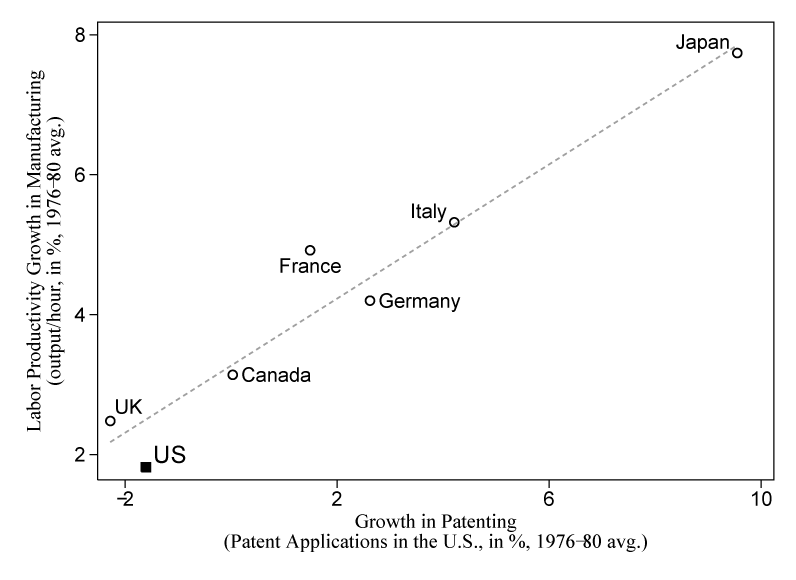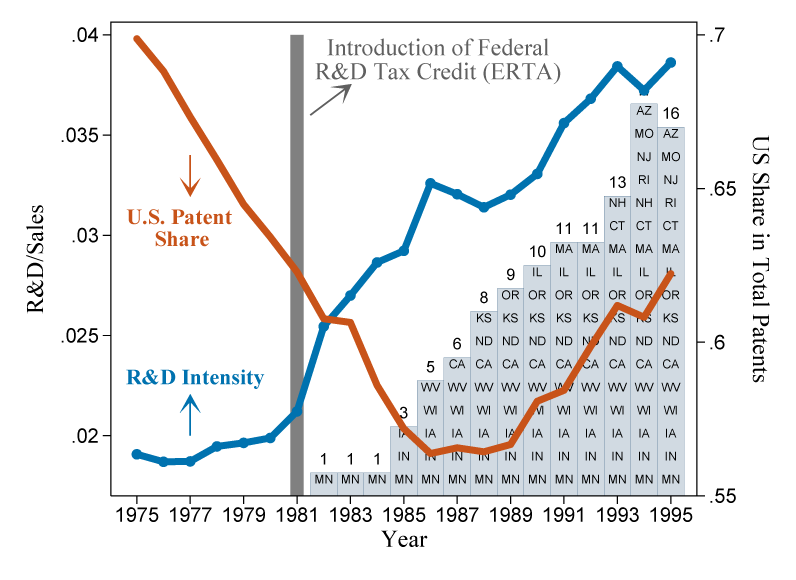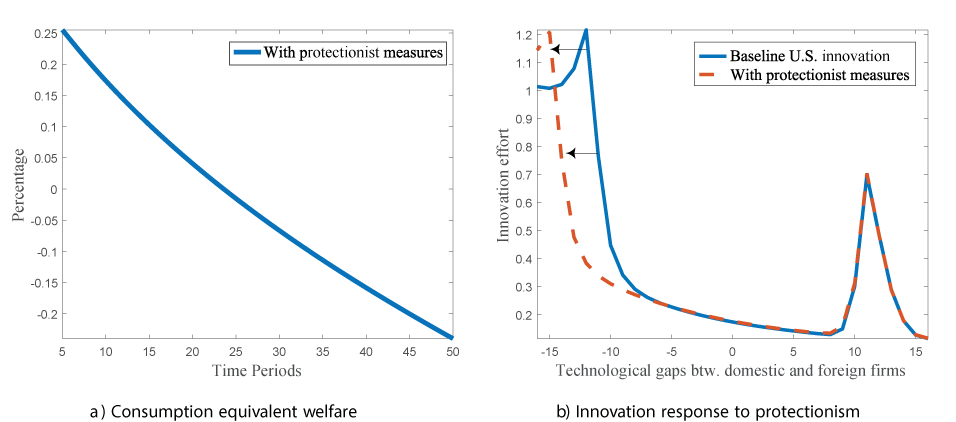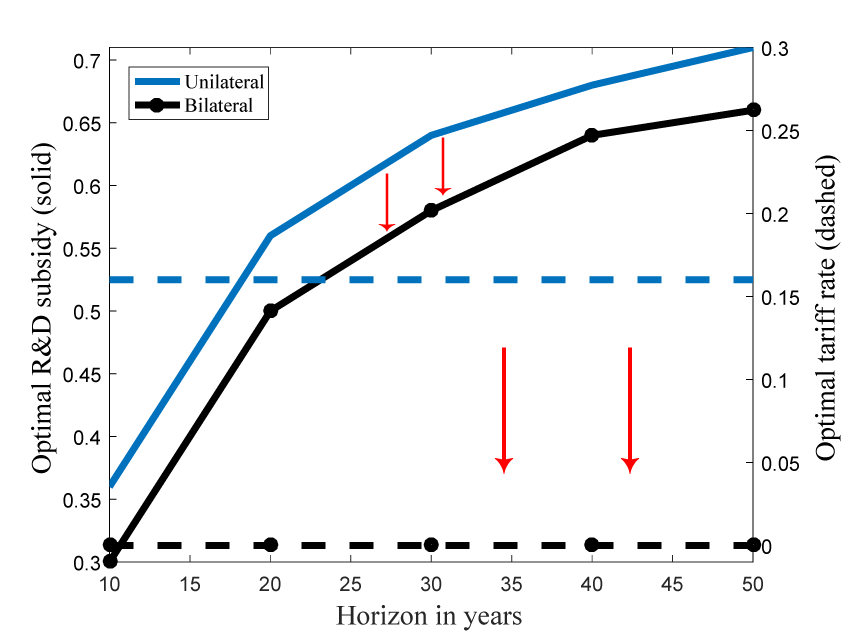FEDS Notes
September 30, 2019
Innovation, Trade Policy, and Globalization
Ufuk Akcigit, Sina T. Ates, and Giammario Impullitti1
What is the optimal set of industrial policies to tackle increased competition from global technological rivals? Drawing on U.S. experience three decades ago, we examine the effects of import tariffs and research and development (R&D) subsidies on domestic firms' global competitiveness, aggregate growth, and welfare. We argue that import tariffs generate large dynamic productivity losses and may enhance welfare in the short run only and when trading partners do not retaliate. By contrast, R&D subsidies stimulate domestic innovation and increase welfare, especially over longer time horizons, without jeopardizing the gains from trade.
The U.S. government's concerns about what it deems unfair trade practices on the part of China resulted in increases in tariffs over the past couple of years on certain imports from that country. China quickly retaliated with tariffs of its own on various U.S. imports. Concerns were also raised in the 1970s and early 1980s, when the United States remarkably lagged advanced countries such as Japan, Germany and France, in terms of technology and productivity improvement (see Figure 1). In contrast to protectionist measures, the Reagan administration introduced, among other policies, an R&D tax credit scheme in 1981 for the first time in U.S. history, followed by additional support from individual states. Figure 2 shows that, subsequently, R&D and innovation activity picked up in the United States.2
The recurring debate about global competition and the optimal industrial policy response calls for a deeper understanding of the diverse mechanisms through which these policies affect firms, with the implications likely to vary with the time period under consideration.

Note: Taken from Akcigit et al. (2018). The figure shows the relationship between growth of average labor productivity in the manufacturing sector and growth in the number of patent applications for the United States and its major trading partners between 1976 and 1980. Akcigit et al. obtain data on patent applications in the United States from the USPTO and on international productivity comparisons from Capdevielle and Alvarez (1981).

Note: Taken from Akcigit et al. (2018). The figure shows the evolution of aggregate R&D intensity (defined as the ratio of total R&D spending to total sales) of the public U.S. firms listed in the Compustat database, and the share of patents registered by U.S. residents in total patents registered in the USPTO database from 1975 to 1995. The ratios are calculated annually. The bars show the total number of U.S. states providing R&D tax credits, along with their names, for every year since the first adoption of such a measure in 1982 in Minnesota. Data on the state-level provision of R&D subsidies are obtained from Wilson (2009).
A long series of studies has examined the effect of trade openness and trade policies on firm behavior and aggregate productivity level (Eaton and Grossman 1986; Grossman and Helpman 1991; Melitz 2003; Demidova and Rodríguez-Clare 2009; Costinot and Rodríguez-Clare 2014, among others). Despite the early seminal work by Grossman and Helpman (1991), however, the dynamic link between trade and firms’ innovation decisions, the engine of factor-productivity growth, has only recently gained traction (Burstein and Melitz 2013). Moreover, given the dynamic links between trade and innovation, policy horizons and transitional dynamics are of utmost importance in trade policy analysis. Taking these considerations seriously, this note examines the optimal mix of tariff policies and R&D subsidies to support domestic firms in global technological competition and to enhance aggregate welfare.
In a recent paper, we build a dynamic model of international trade and innovation where firms compete strategically in production and innovation (Akcigit et al. 2018). A central feature of our framework is that firms' production and innovation decisions depend on their technological position relative to their foreign competitor, reflecting the strategic interactions between large firms. Such firms dominate global R&D races and international trade, and their choices affect market aggregates and give rise to strategic market power. For example, Airbus and Boeing dominate the technology-intensive aircraft industry (Baldwin and Krugman 1988; Irwin and Pavcnik 2004), and the top 1 percent of U.S. trading firms account for about 80 percent of total U.S. trade. Our framework captures the dynamic relationship between trade and firm innovation--and thus aggregate growth and welfare. In our quantitative exercises, we focus on the heterogeneous implications of industrial policies for aggregate growth and welfare across different time horizons, accounting for the different transitional dynamics these policies generate.
Model description
We build a two-country dynamic endogenous growth model where innovation determines the dynamics of technology and global market leadership. In both countries, final-good firms produce output with a set of intermediate inputs, sourced from domestic and foreign producers. In each intermediate sector, a home firm and a foreign firm compete for global market share and invest in R&D to improve the quality of their product. Based on step-by-step innovation models of Schumpeterian creative destruction, this model structure allows for heterogeneous between-firm technology differences across intermediate sectors. Endogenous entry by a fringe of domestic and foreign firms creates additional competitive pressure for both leaders and followers in each sector. International markets are characterized by trade costs and the international diffusion of ideas through knowledge spillovers.
A key mechanism is that trade openness affects the economies' dynamics by changing firms' motives for innovation. In the model, positive trade costs render trade unprofitable unless the foreign good has a large enough quality advantage. Therefore, when a domestic firm's quality is too inferior, the particular intermediate good that it is able to produce is imported. But a marginal improvement in its quality renders the domestic sourcing of the good more profitable for the domestic final-good producer than importing it thanks to trade barriers. Hence, the domestic intermediate-good firm exerts additional effort to take the leadership in the home market from the technologically superior foreign firm (defensive R&D). Similarly, when the technological advantage of a domestic intermediate producer is large but not enough to export covering trade costs, it intensifies its innovation effort to improve its technological lead just a bit more and enter the foreign market (expansionary R&D). These novel implications generate a double-peaked distribution of R&D effort over the relative quality space of firms that, remarkably, is also supported by USPTO patent data (illustrated in Figure 3B, see the discussion below). From a policy point of view, the distinction between defensive and expansionary R&D is crucial, because they generate different responses to alternative industrial policies.
Quantitative findings
We parameterize the model to match key trade, innovation, and growth facts in the late 1970s and reproduce the evolution of global leadership in those years, with the United States initially representing the technological frontier in most sectors. The transitional dynamics of the model reproduce the convergence in technological leadership--i.e., the higher rate of patent production by foreign countries--observed in patent data in the 1970s and early 1980s. The model's mechanism is fairly successful in matching empirical patterns for the link between innovative activity and technological leadership that are not targeted and the elasticity of firm R&D spending to policy changes.
Raising import tariffs unilaterally
In the first policy exercise, we analyze the welfare implications of protectionism--raising import tariffs unilaterally. The welfare implications of this policy change depend on the time horizon over which the policy is evaluated. A rise in tariffs generates short-run gains, because it tames international business-stealing caused by foreign technological catch-up, keeping business profits at home (see Figure 3A). These gains more than compensate for the negative effect on aggregate productivity of replacing better-quality imported goods with inferior domestic counterparts. But protective measures reduce the incentives for domestic firms to invest in defensive innovation, because they weaken domestic firms' exposure to foreign competitive pressures (see Figure 3B). As time goes by, this force dominates, leading to a substantial welfare decline in the long run. Weaker foreign competition caused by protection and the ensuing reduction in defensive innovative activity also shape the optimal trade policy in our model: Lower tariffs are preferred when the welfare impact is evaluated over a longer time horizon.
Increasing R&D subsidies
As an alternative policy option to protectionism, we fed the model with an increase in R&D subsidies, replicating the U.S. move in the early 1980s. The subsidy increase generates non-negligible welfare gains in both the short and long run (except perhaps in the initial years, when higher R&D spending reduces the resources for consumption). By reducing the cost of innovation, subsidies stimulate both entrant and incumbent firms' R&D in the United States, thus accelerating productivity growth and allowing U.S. firms to attain market leadership. Our findings suggest that the observed increase in subsidies was an optimal response only for a very short time horizon, while longer policy horizons call for much higher subsidies, as the growth-stimulating impact of subsidies becomes stronger over time.

Note: The figure illustrates the effects of a unilateral 50 percent increase in U.S. tariffs (protectionist U.S. policy without retaliatory response). Panel A shows the welfare change in consumption-equivalent terms on the vertical axis over different time horizons (in years) on the horizontal axis. The consumption-equivalent change measures the required percentage change in consumption at every point time that makes the representative consumer in the baseline economy (without policy change) indifferent consuming the alternative consumption path that would arise in the economy subject to policy change. Panel B shows of the optimal innovation intensity of U.S. incumbent firms as a function of technology gaps in two scenarios. In the model, technology gaps correspond to the relative quality difference between the leader and the follower in the same sector. In a sense, they measure the difference between the total numbers of technology rungs which determine the firms' product qualities. The peaks in the innovation-effort profile reflect defensive and expansionary R&D efforts.
Optimal policy mix
The dynamics discussed above suggests that different combinations of R&D subsidies and tariff rates may be optimal at different time horizons. For example, with unilateral tariffs, protectionist trade measures could be optimal provided they are combined with aggressive R&D subsidies, as demonstrated by the blue lines in Figure 4. The reason is that protectionist policies protect domestic profits but reduce innovation incentives. So aggressive R&D subsidies are needed to make up for the reduced innovation efforts. However, this result depends crucially on the assumptions of no retaliatory response from trading partners. If the trade partners retaliate, the optimal trade policy reverses and calls for a regime as liberal as possible, with hardly any tariffs being optimal (dotted black lines in Figure 4). The risk of losing the export market is key in this reversal.

Note: The figure compares horizon-dependent optimal joint policy over different time horizons in the case of (trade-policy) retaliation to that in the baseline. Solid lines (left axis) show the level of R&D subsidies, while dashed lines (right axis) show the tariff level.
Effect of falling trade costs
Last but not least, our analysis shows that less policy intervention is needed as the world becomes more globalized through reduced trade costs. This interesting result arises because lower trade costs intensify competition in the global marketplace. More-competitive markets induce more innovation, both defensive and expansionary. In other words, with globalization, markets take care of the innovation incentives and eliminate the need for policy intervention.
References
Akcigit, Ufuk, Sina T. Ates and Giammario Impullitti, "Innovation and Trade Policy in a Globalized World," NBER Working Paper 24543, 2018.
Baldwin, Richard and Paul Krugman, "Industrial Policy and International Competition in Wide-bodied Jet Aircraft," in Richard Baldwin, ed., Trade Policy Issues and Empirical Analysis, University of Chicago Press, 1988, pp. 45-78.
Burstein, Ariel and Marc J. Melitz, "Trade Liberalization and Firm Dynamics," in Daron Acemoglu, Eddie Dekel, and Manuel Arellano, eds., Advances in Economics and Econometrics Tenth World Congress. Applied Economics, Vol. 2, 2013, pp. 283-328.
Capdevielle, Patricia and Donato Alvarez, "International Comparisons of Trends in Productivity and Labor Costs," Monthly Lab. Rev., 1981, 104, pp. 14-20.
Costinot, Arnaud and Andrés Rodríguez-Clare, "Trade Theory with Numbers: Quantifying the Consequences of Globalization," in E. Helpman, K. Rogoff, G. Gopinath eds., Handbook of International Economics, Vol. 4, 2014, pp. 197-261.
Demidova, Svetlana and Andrés-Clare, "Trade Policy Under Firm-level Heterogeneity in a Small Economy," Journal of International Economics, June 2009, 78 (1), 100-112.
Eaton, Jonathan and Gene M. Grossman, "Optimal Trade and Industrial Policy under Oligopoly," Quarterly Journal of Economics, 1986, 101 (2), 383-406.
Grossman, Gene M. and Elhanan Helpman, International Trade and Trade Policy, Cambridge, Mass.: MIT Press, 1991, chapter 8, pp. 141-163.
Irwin, Douglas A. and Nina Pavcnik, "Airbus versus Boeing Revisited: International Competition in the Aircraft Market," Journal of International Economics, 2004, 64 (2), 223-245.
Melitz, Marc, "The Impact of Trade on Intra-Industry Reallocations and Aggregate Industry Productivity," Econometrica, 2003, 71, 1695-1725.
Wilson, Daniel J., "Beggar Thy Neighbor? The In-state, Out-of-state, and Aggregate Effects of
R&D Tax Credits," Review of Economics and Statistics, 2009, 91 (2), 431-436.
1. Ufuk Akcigit ([email protected]) is a Professor of economics at the University of Chicago, Sina T. Ates ([email protected]) is a Senior Economist in the Division of International Finance of the Federal Reserve Board of Governors, and Giammario Impullitti ([email protected]) is an Associate Professor at the University of Nottingham. We thank Shaghil Ahmed for his comments and Daniel J. Wilson for sharing and helping with his data. The views expressed are solely the responsibility of the authors and should not be interpreted as reflecting the views of the Board of Governors of the Federal Reserve System or of any other person associated with the Federal Reserve System. Return to text
2. While R&D expenditure is a nominal variable, patent applications provide a more direct measure of innovation output. Looking at the fraction of patents registered by the U.S. entities in total patents registered (by both domestic and foreign entities) highlights an interesting reversal in the trend of this ratio. The steady decline in this ratio early in the period implies that the pace of patent production by foreign entities was higher before the mid-1980s, likely suggesting a stronger penetration by foreign firms to the U.S. market. With some lag after the introduction of tax credits, we observe a reversal in this trend, meaning that patent production by U.S.-based entities outpaced that of foreign entities within patents registered in the United States. Return to text
Akcigit, Ufuk, Sina T. Ates, and Giammario Impullitti (2019). "Innovation, Trade Policy, and Globalization," FEDS Notes. Washington: Board of Governors of the Federal Reserve System, September 30, 2019, https://doi.org/10.17016/2380-7172.2456.
Disclaimer: FEDS Notes are articles in which Board staff offer their own views and present analysis on a range of topics in economics and finance. These articles are shorter and less technically oriented than FEDS Working Papers and IFDP papers.